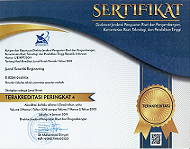Perbandingan Efektivitas Bioaktivator MOL Kulit Pisang Kepok (Musa paradisiaca L.) dan EM4 Dalam Pengomposan Limbah Daun Srobilanthes cusia Secara Aerob
Keywords:
MOL kepok banana peel and EM4, composting, solid organic fertilizerAbstract
The production process of natural indigo dye from the Strobilanthes cusiaplant has solid leaf waste as a by-product from maceration residue. This waste can be used to make solid organic fertilizer. This research aims to determine the effective concentration of adding local microorganism (MOL) ofkepok banana peel and EM4 to bioactivators obtain good quality compost. Composting was carried out aerobically with variations in the concentration ratio of kepok banana peel MOL and EM4 bioactivators of 1%, 2%, 3%, 4% and 5% respectively. Fertilizer quality is determined by testing the C/N ratio parameter using the Walkey & Black (C-Organic) and Kjeldahl (N-Total) methods. Color, texture and odor tests were carried out organoleptically by 5 panelists. The results showed that in the concentration range of 1-5%, the MOL kepok banana peel bioactivator was more effective than EM4, as evidenced by the lower C/N ratio of the compost. The best product was obtained from the composting process with 5% MOL kepok banana peel bioactivator with a C/N ratio of 50.04%, water content of 48.74%, blackish brown color, very crumbly texture and an earthy smell. This result does not meet the standards for compost quality according to SNI 19-7030-2004, but the physical parameters such as color, texture, odor and water content meet the standards, namely blackish brown color, very crumbly texture and smells like soil.












